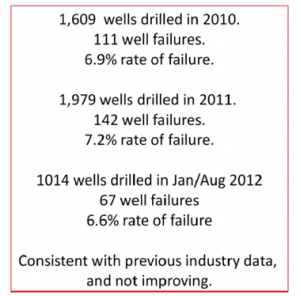PA Representative Calls for Probe of DEP Water Testing Reports
November 3, 2012Danger If Ohio Watershed Conservancy District Leases Reservoirs for Fracking
November 14, 2012 Casing failure leading to fluid migration is explained by Dr. Ingraffea in his latest paper. This is the same subject covered in Josh Fox’s “The Sky is Pink” – Though Fox’s short film also tackles aspects of how the media influences public discourse. The “fluids” that can migrate are liquids and also gasses – like the mixture that is natural gas. The fastest moving part of this mixture (because it’s the lightest and smallest) is the major component – methane. “Gas migration” is an effect often seen where gas drilling with hydraulic fracturing is done. There is no question that degradation happens where drilling is done, but how to prove that levels of gas rising to the land surface, in streams and in drinking water were not there “before”? You need a pre-drill methane area BASELINE.
Casing failure leading to fluid migration is explained by Dr. Ingraffea in his latest paper. This is the same subject covered in Josh Fox’s “The Sky is Pink” – Though Fox’s short film also tackles aspects of how the media influences public discourse. The “fluids” that can migrate are liquids and also gasses – like the mixture that is natural gas. The fastest moving part of this mixture (because it’s the lightest and smallest) is the major component – methane. “Gas migration” is an effect often seen where gas drilling with hydraulic fracturing is done. There is no question that degradation happens where drilling is done, but how to prove that levels of gas rising to the land surface, in streams and in drinking water were not there “before”? You need a pre-drill methane area BASELINE.
Summary of the Ingraffea paper:
The most recent experience with shale gas wells in the Pennsylvania Marcellus play reflects long term, world-wide industry data with respect to new wells with compromised structural integrity. Operator-wide statistics in Pennsylvania show that about 6-7% of new wells drilled in each of the past three years have compromised structural integrity. This apparently low failure rate should be seen in the context of a full buildout in the Pennsylvania Marcellus of at least 100,000 wells, and in the entire Marcellus, including New York, of twice that number. Therefore, based on recent statistical evidence, one could expect at least 10,000 new wells with compromised structural integrity. It is too early to discern whether the other industry experience with this technical problem, an increase in loss of integrity with well age, will also be reflected. However, at play in modern shale gas development are many of the key factors identified by industry researchers as having a negative influence on well structural integrity: the need for deviated wells, rapid development of a field, presence of “shallow” high-pressure gas horizons, and disturbance of young cement due to adjacent drilling activities on the same pad.
CLICK HERE for the full report.



